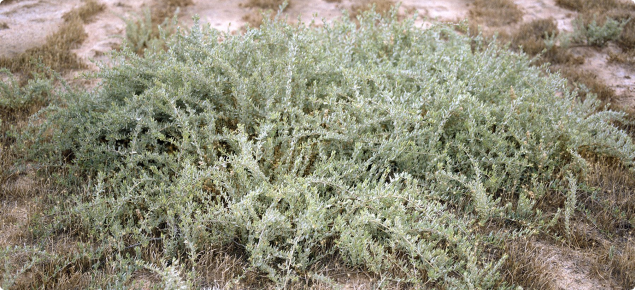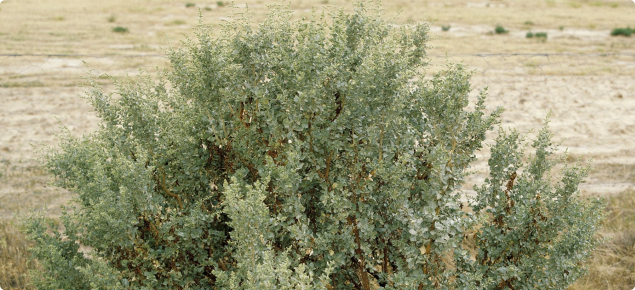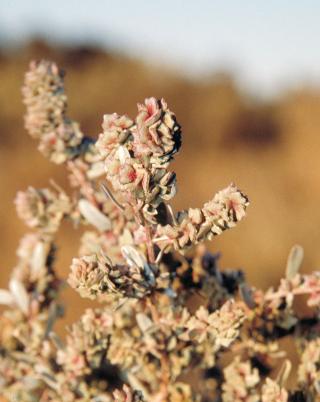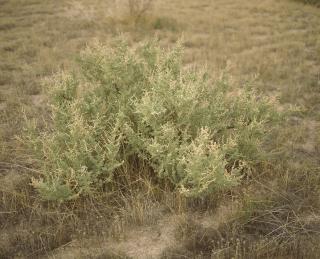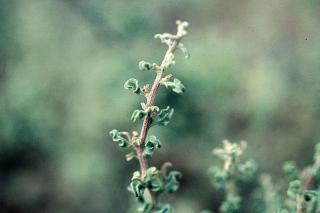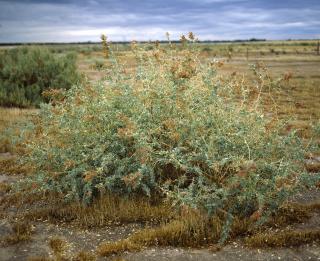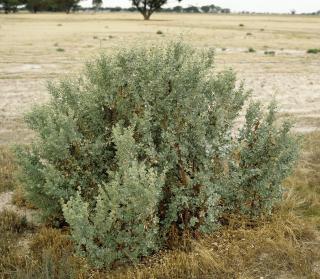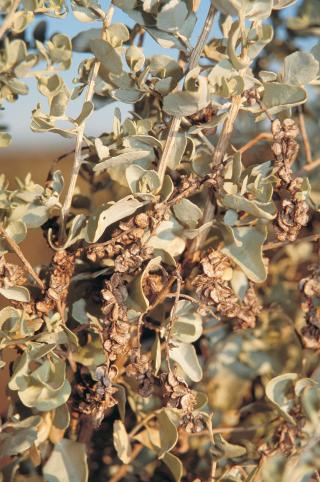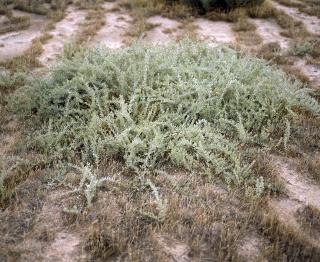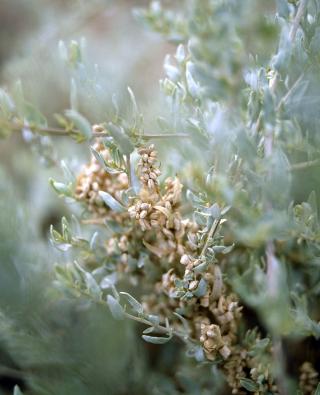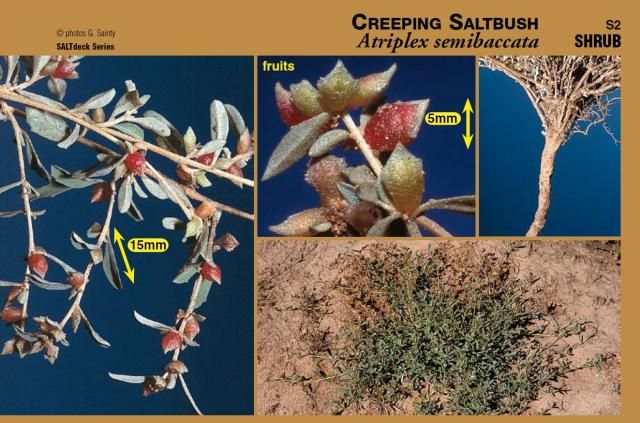What are saltbushes?
Saltbushes are halophytic ('salt loving') shrubs in the plant family Chenopodiaceae, and mostly in the genus Atriplex.
Western Australian research scientists and farmers have been at the forefront of saltbush pasture development since the 1950s.
Early work showed that saline land could be more productive using old man saltbush (Atriplex nummularia), creeping saltbush (A. semibaccata) and small-leaf bluebush (Maireana brevifolia). However, these species had problems: old man saltbush had low palatability and erect branches partly out of reach of sheep, creeping saltbush was short-lived, and small-leaf bluebush was sensitive to waterlogging.
Research on farms in the 1970s and 1980s selected saltbush genetic material, based on soil conditions, plant growth and habit, flowering, seed production and ability to produce volunteers, resistance to pests and diseases, waterlogging tolerance, drought tolerance and resistance to sand blasting.
From this early work, and more recent research, the highest ranked saltbushes are:
- river saltbush (Atriplex amnicola)
- wavy-leaf saltbush (A. undulata)
- quailbrush (A. lentiformis)
- old man saltbush (Atriplex nummularia)
- grey saltbush (Atriplex cinerea)
- creeping saltbush (Atriplex semibaccata).
Some of these saltbushes, and other useful salt-tolerant pasture plants, are from overseas: puccinellia (Puccinellia ciliata from Turkey), wavy-leaf saltbush (Atriplex undulata from Argentina), tall wheat grass (Thinopyrum ponticum from southern Russia), quailbrush (Atriplex lentiformis from the US) and distichlis (Distichlis spicata from the United States).
Suitable sites for saltbush
In areas where the rain falls predominantly in winter, halophytic shrubs are likely to be key groundwater-using elements. However, in areas with substantial summer rainfall, halophytic grasses are likely to be more important users of groundwater.
Figure 1 shows the relative tolerance of saltland species to salinity and waterlogging levels.
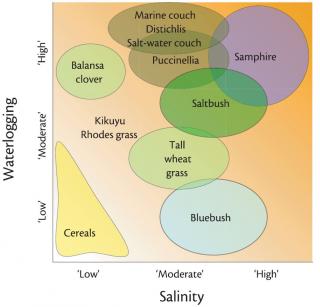
Salinity and watertable depth
Measure soil salinity and monitor groundwater to characterise a site.
Measures and suitability are:
- Winter watertable: best 0.3 to 0.7m below the surface; poor less than 0.3m
- Summer watertable: best 1.5 to 2.5m below the surface; moderate 1.0 to 1.5m; poor less than 1.0m
- Subsoil salinity (25–50cm) ECe: best 800–1600mS/m; moderate 200–800mS/m; poor greater than 1600mS/m
Waterlogging and inundation
Diagnose the degree of expected waterlogging and then choose management and species to suit those conditions.
Saltbush is relatively sensitive to waterlogging and inundation, particularly if waterlogging is prolonged or occurs during periods of high temperature.
Old man saltbush is generally more sensitive to waterlogging than river saltbush.
Prevent inundation by:
- choosing sites that have limited inundation
- using shallow relief drains
- planting the saltbush on mounds – arrange the mounds in a herringbone or fishbone pattern with the rows sloping towards the natural drainage line.
Soils
Saltbush grows beter on soils that are lighter than heavy clays. Direct seeding to establish saltbush is only possible on sandy/loamy soils, or where there is a sandy/loamy layer over a heavy clay.
Very acid soils may reduce saltbush growth.
Rainfall
- 250–450mm is the preferred range
- less than 250mm has a high risk of establishment failure and reduced productivy
- greater than 450mm has a high likelihood that waterlogging will be a constraint.
Temperature
Saltbush is a summer grower and optimum growth occurs when daytime temperatures are in the range 30–35°C. Saltbush is usually dormant or slow growing during the colder months: river saltbush has little growth when the mean daily temperature is below 13°C; old man saltbush still has some growth in winter.
Old man saltbush has shown better tolerance to low temperature than river saltbush, and will withstand quite severe frosts. We recommend perennial grasses – such as tall wheatgrass and puccinellia – in preference to saltbushes for saline sites in the cooler and/or wetter areas across southern Australia.
Planting design for saltbushes
We recommend using block planting of saltbushes for moderate to severely-affected saltland (ECe 800–1600mS/m), and belt planting for mild to moderately affected saltland (ECe 200–800mS/m). Belt planting allows the alleys to be planted to highly productive salt tolerant grasses and legumes.
As salinity levels increase, increase saltbush density (plants per hectare).
Block planting
An example is in Figure 2.
Block plantings are best used on moderate to severely-affected saltland and can range from 1000 to 1600 plants per hectare. Table 1 below shows planting distances and densities to use according to salinity class.
| Saltland class | Distance between plants (m) | Distance between rows (m) | Plant density (plants/ha) |
|---|---|---|---|
| Moderate | 2 | 5 | 1000 |
| Moderate | 2.5 | 4 | 1000 |
| High | 3 | 3 | 1100 |
| High | 2.5 | 2.5 | 1600 |
When planning, include the occasional 10m wide track for vehicle access. The image above shows a block planting of old man and river saltbush at Ongerup. Rows are 2.5m wide and plants are 2.5m apart giving a density of 1600 plants per hectare.
Belt planting
An example is in Figure 3.
In the Tambellup belt planting (Figure 3), tall wheat grass (seen in the alley) was sown first with an airseeder, then saltbush was planted in sets of 4 rows, with rows 2.5m wide and plants 2.5m apart. The alley is 10m wide, giving a planting density of 910 plants per hectare.
Belt plantings are best suited to mild to moderate saltland. A common configuration is 2 to 4 rows of saltbush with the width of the alleys dependent on severity of salt. Generally the more saline, the more saltbush plants are required and consequently alley widths reduce. Planting density can range from 600 to 960 plants per hectare.
| Saltland class | Alley width (m) | Distance between plants (m) | Distance between rows (m) | Plant density (plants/ha) |
|---|---|---|---|---|
| Slight | 20 | 2 | 5 | 600 |
| Moderate | 12 | 2.5 | 4 | 800 |
| Moderate | 10 | 3 | 3 | 960 |
Benefits of saltbush
Saltbush can:
- provide sheep feed – low to moderate quality and quantity (not taking understorey into account)
- lower watertables – by a low to moderate amount, depending on the site (Figure 4)
- reduce salt export from a site – moderate to high reductions on most sites
- reduce wind exposure and wind erosion – a high level of protection for the ground surface and for livestock
- improve amenity values – depending on the site, visual amenity can be improved a little or a lot
- provide fauna habitat – depending on management, habitat can be increased for birds and other native fauna.
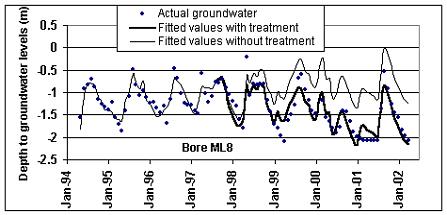
The groundwater graph shows changes from 1994 to 2002 for no saltbush (thin line) and with saltbush (thick line) at Lake Grace. Water levels were reduced by 0.9m. Lowering the watertable by a small amount and drying the surface soil layer prevents salt concentrating on the soil surface, and then moving offsite with heavy winter rains. This can prevent up to 80% of salt moving offsite in surface water.
Value of saltbush for sheep feed
As a sole diet, most saltbush has low digestibility, relatively low metabolisable energy (less than that required for a maintenance diet for sheep or cattle), high salt concentrations (up to 20% or more of the dry weight) and moderate to high crude protein (12–20%). Old man saltbush is generally more digestible, with lower salt content than other saltbushes, espcially if grown on slightly or non-saline soils.
The total digestible dry matter production per hectare from saltbush alone is usually low. It is easy to over-estimate the available forage supply in saltbush pastures, based on visual assessment, because of the upright habit of the plants. However, understorey feed production is easy to underestimate, because it is hidden below the shrubs.
Energy
Saltbush leaves are reasonably digestible, but small stems make up much of the edible portion of saltbush and these have very low digestibility, which means the total intake has a low digestibility (46–62%) that is less than maintenance. A 50kg sheep would need to eat more than 1000 grams (g) of saltbush dry matter per day on a straight saltbush diet to maintain condition. However, this is impossible with saltbush, because the high salt concentration in the feed limits intake to about 800g, depending on the level of salt in the soil and in the plant’s leaves.
Protein
The very high crude protein content (typically 12–20%) of saltbush is valuable in summer and autumn, when green feed (and therefore protein) can be very limited.
About half the crude protein in saltbush is not protein at all, but nitrogen contained in a range of other compounds, primarily those that are used to assist the plant cells manage the high salt loads. This non-protein nitrogen can be converted into microbial protein in the rumen if there is a good supply of energy available. This is unlikely to be the case in dense saltbush plantings, that have little or no under-storey of high energy forage. Provide energy from stubbles, dry non-saline pastures, or supplementary feeds.
Salt
The high salt content of most saltbush limits feed intake. The feeding value of high-salt saltbush can be improved by feeding low-salt supplements (grain and or high quality hay). Sheep will actively select quantities of high and low salt feeds that improve the feeding value of their diet.
Water
For sheep to cope with high levels of salt in the diet, they must have access to low-salt drinking water. Saline drinking water will reduce feed intake even more. In one study, feed intake of sheep on old man saltbush fell by more than half when the drinking water was replaced by water containing 1% salt (10 000ppm). See livestock water requirements for more information.
Vitamin E
Old man saltbush is an excellent source of vitamin E, containing about 250mg vitamin E per kilogram of green leaf. Dried annual pastures can be highly deficient in vitamin E, which can cause a muscle wasting disease in sheep.
On its own, saltbush leaf is a maintenance forage for sheep. It has relatively low digestibility and high ash concentrations (17–33%) reducing its value as a source of metabolic energy.
However, saltbush leaves also contain high concentrations of nitrogen. Average crude protein concentrations of 15% have been found. The exact form of this nitrogen is not known, but it is accessible to ruminants provided adequate energy is available from other sources.
Saltbush does not tolerate long-term continuous grazing and plants should be allowed to recover after grazing.
The plants use groundwater, which can assist in the growth of other higher value understorey species. It seems likely at least some of the grazing benefits achieved on saltbush-based pastures have been caused by improvements in understorey.
Choosing the right saltbush species for the site and purpose
Climate can affect the choice of saltbush species to be planted. In WA, river saltbush grows well in the warmer northern agricultural areas, but in the cooler areas of the south coast there is little difference in productivity between river and wavy leaf saltbush.
| Common Name | Species Name | Salinity tolerance | Waterlogging tolerance | Palatability | Grazing recovery | Suitability for direct seeding |
|---|---|---|---|---|---|---|
| Old man saltbush | Atriplex nummularia | xxxx | xx | xx | xxxx | xx |
| River saltbush | Atriplex amnicola | xxxx | xxx | xxxx | xxxx | xx |
| Wavy leaf saltbush | Atriplex undulata | xxxx | xxx | xxx | xx | xxxx |
| Quail brush | Atriplex lentiformis | xxxx | xxx | xxxx | xxx | xxx |
Note: there is a newer, more palatable selection of old man saltbush (Anameka Saltbush™), but this needs to be established as nursery raised seedlings, which would be too expensive for the return in a dense saltbush planting, but would suit saltbush plus understorey.
River saltbush (Atriplex amnicola)
Of all saltbushes tested on saltland in Western Australia, river saltbush (Atriplex amnicola) had the best long-term survival. It has moderate–high salinity tolerance and high drought tolerance. Once established, it can tolerate winter waterlogging although prolonged waterlogging, especially in summer, will cause death. It will survive partial inundation, but total immersion will kill it .
Occurrence
It is native to the creeks and outer margins of salt lakes in the Murchison and Gascoyne River Basins of WA.
Description
River saltbush is a perennial shrub that can have a prostrate to erect habit. The branches of the prostrate types form roots where they rest on the ground. The bushes are usually one metre wide and high, but larger ecotypes may reach four metres across and 2.5 metres high.
Leaf size and shape, and leafiness and fruit shape vary widely. Leaves are often elongated and spear-shaped, but can be oblong with rounded ends, one to 3cm long. The species is mainly dioecious, although monoecious plants may occur. Male flowers are in dense clusters on the ends of branches. Female flowers are at stem nodes (Figure 5) and in short clusters on the ends of branches (Figure 6).
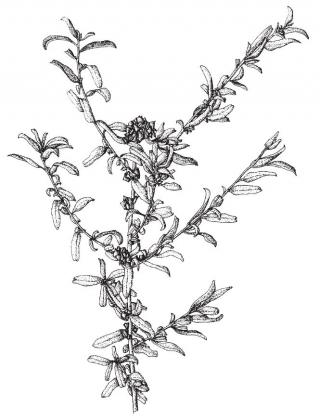
Fruits may be woody or more papery, 2 to 6mm across, roughly triangular or spherical in shape. Seed is usually harvested in late summer. Flowering varies, depending on seasonal conditions.
Grazing
River saltbush is palatable and has a remarkable ability to recover from heavy grazing (Figure 7).
Establishment
Clones of river saltbush strike readily from cuttings. Special care needs to be given to establishment from seed. River saltbush is more susceptible to waterlogging during germination than wavy leaf saltbush. It has been difficult to establish by direct seeding. Two more easily established lines (Rivermor and Meeberrie) have been selected . Except for Rivermor and Meeberrie, river saltbush usually produces few volunteer seedlings.
Wavy-leaf saltbush (Atriplex undulata)
Wavy-leaf saltbush grows well on salt affected soils in areas receiving 250–500mm annual rainfall and establishes readily from seed in the field. It does not appear to be as tolerant to waterlogging as river saltbush (Atriplex amnicola). .
Occurrence
Wavy-leaf saltbush comes from the semi-arid rangelands of central Argentina.
Description
Wavy-leaf saltbush is a short-lived perennial shrub to 1m high and 2m wide. Stems can be erect or low spreading. Low stems trailing on the ground may form roots. Leaves are 0.5–2cm long, occasionally to about 5cm and wavy (undulate) (Figure 8).
Generally, male and female flowers are on separate plants (dioecious). Male and female flowers occur in clusters on the ends of the branches. The fruits are soft and rounded, 1–3mm diameter and contain a single seed, which ripens in April – May. Fruits are round and soft, containing one seed that matures in autumn.
Grazing
Dense stands are a maintenance diet for sheep if good quality water and hay are available. Grazing value is higher when grown with an annual legume understorey. Low energy value but good crude protein. Leaves contain up to 28% salt, so supplements (grain, pasture or hay) and good quality drinking water are essential.
Grazing
With repeated grazing every autumn, wavy leaf saltbush may die.
Establishment
Wavy-leaf saltbush establishes readily from seed using the niche seeder. Seed can spread through animal faeces; volunteer seedlings establish in large numbers following autumn grazing.
Quailbrush (Atriplex lentiformis)
Quailbrush is a rapidly growing species, moderately tolerant to salinity, tolerant to heat and drought, and well adapted to warmer climates. Its erect, open, angular growth habit is not well suited to grazing, but its large size provides shelter. For reasons that are unclear, it tends to die back in saline waterlogged land after several years. It is being grown in areas receiving 300–450mm average annual rainfall.
Occurrence
Quailbrush comes from the hot arid deserts of southern California and Arizona, USA.
Description
Quailbrush is a fast-growing perennial shrub with open, upright structure up to 2.5m high and wide. The silvery blue-green leaves are about 2cm long. Male flowers are clustered on the ends of branches. Female flowers, which often turn pink before ripening, hang in dense bunches. Fruits are flat and round, 2–5mm in diameter. The seed ripens in April to May.
Grazing
The bush is erect and woody. Sheep graze it readily.
Establishment
It readily establishes from seed using the niche seeder. Seedlings also establish naturally after autumn grazing.
Old-man saltbush (Atriplex nummularia)
To a substantial degree, old man saltbush is Australia’s iconic saltbush species (Figure 12). It grows well on saline soils in agricultural and rangeland areas where annual rainfall ranges from 175mm to 400mm. It is a deeper rooted plant than many other saltbushes. Waterlogging, especially in summer, bleaches the leaves and can kill the plants. Its main disadvantages as a fodder plant are its upright growth habit, a poor ability to produce volunteer seedlings and low palatability to grazing sheep. It has been advocated as a fodder reserve in times of drought in NSW.
Occurrence
Old man saltbush is native to the semi-arid and arid zone of southern and central Australia; it is often associated with heavy soils or flood plains.
Description
Old-man saltbush is highly drought tolerant, moderately tolerant to salinity; it is long-lived on soils not subject to waterlogging. It has an upright habit, and may grow to 2m high and 1.5m wide. The leaves are grey-green, 2–4cm long and irregularly shaped.
Male flowers occur in dense clusters (Figure 13). Female flowers are in 20cm long bunches.
Fruits are fan-shaped to nearly round, woody towards the base and up to 6mm across. Fruits (Figure 14) ripen by late summer.
Grazing
Old man saltbush has a lower palatability than some other saltbushes. A variety, De Kock, with better palatability is gaining acceptance. The species recovers from grazing, but the branches are brittle and may get trampled.
Across a range of environments, the new selection of old man saltbush – Anameka Saltbush™ – had a mean organic matter digestibility of 64%, crude protein of 19.5% and 25% ash. This nutritional profile and improved relative palatability is likely to increase voluntary intake, provide higher energy values and increased livestock productivity. This in turn should increase the effectiveness of understorey energy sources.
Establishment
We recommend using nursery grown old-man saltbush selections with higher palatability. Nursery raised seedlings are relatively expensive at high planting densities (more than $500 per hectare).
Historically, old man saltbush has been difficult to establish by direct seeding on clay soils. However, good results at much lower cost have been obtained on clay soils in the Murray-Darling Basin using a new seeder developed by Greening Australia Victoria and Kerang Engineering. Before sowing, fruits of old man saltbush should be washed under running water for two to four hours to leach salt and other compounds that inhibit germination.
Grey saltbush (Atriplex cinerea)
Grey saltbush is a highly productive shrub that grows on saline seepages in the WA wheatbelt and tolerates moderate waterlogging.
Occurrence
Grey saltbush grows on coastal dunes of southern Australia (Figure 15)
Description
Grey saltbush is a perennial shrub with prostrate (Figure 16)) and erect forms. The prostrate form can grow 6–8m in diameter and 0.5m high. Its leaves are up to 2cm long, grey-green, with a sheen on the upper and lower surfaces. The erect form found in southern and eastern Australia has larger, greyer leaves. It can be dioecious or monoecious.
Male flowers occur in dense clusters on the ends of branches. Female flowers occur in clusters in leaf axils of upper parts of branches. Fruits (Figure 17) are hard, 2–6mm long and wide, roughly triangular, containing a single seed, which ripens in late summer .
Grazing
The species is variable in palatability and recovers well from grazing.
Establishment
Establish from seed or cuttings.
Creeping saltbush (Atriplex semibaccata)
Alternative name: Berry Saltbush
Description
Prostrate perennial sub-shrub to 40cm high. Male and female flowers in small clusters in the leaf axils. Grows scattered or in clumps. Flowers summer.
Creeping saltbush (Figure 18) is native to Australia and widespread in all mainland States. Individual plants are short-lived perennials. It is a prostrate perennial shrub to 40cm high. Male and female flowers occur in small clusters in the leaf axils. Plants grow as scattered individuals or in clumps and flower over summer. Its key features are the leaves which are green to grey-green above and whitish below, and the diamond-shaped fruit 4–6mm long which are sometimes red and succulent when fresh. Seeds prolifically and these can be collected in late summer by shaking the plant.
Key features
Leaves green to grey-green above, whitish below. Fruit 4–6mm long, roughly diamond-shaped, sometimes red and succulent when fresh (see photo).
Value
Very palatable, especially when young. Low energy value and good crude protein. Leaves contain up to 25% salt, so supplements (grain, pasture or hay) and good quality drinking water are essential. Easily overgrazed if set-stocked.
Salinity and waterlogging tolerance
Moderate tolerance to salinity. Low tolerance to waterlogging
References
- Flora of South Australia, Jessop and Toelken (eds), Part 1, 4th edition 1986. Flora of Victoria
- Walsh and Entwisle (eds), Vol. 3, 1996.
- Flora of NSW, Harden (ed), Vol. 1, 1990. Plants of Western NSW, Cunningham et al., 1981.
- Forage Shrubs and Grasses for Revegetating Saltland, Runciman and Malcolm, WA Department of Agriculture Bulletin 4153, 1991


